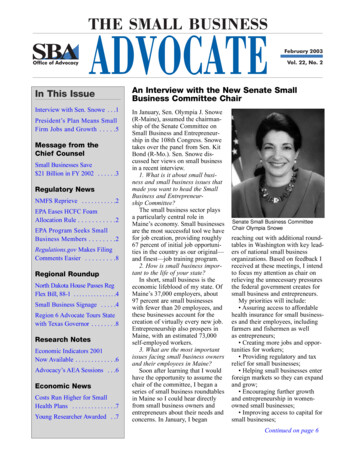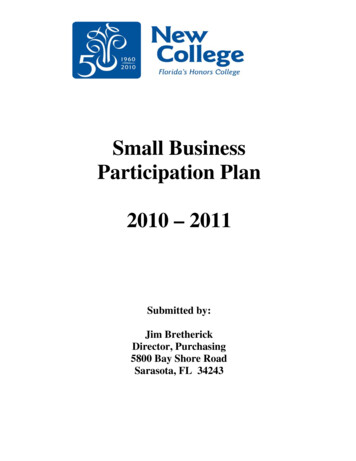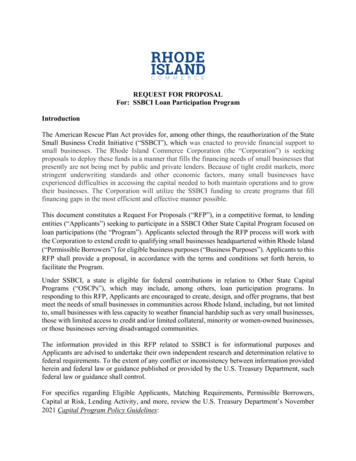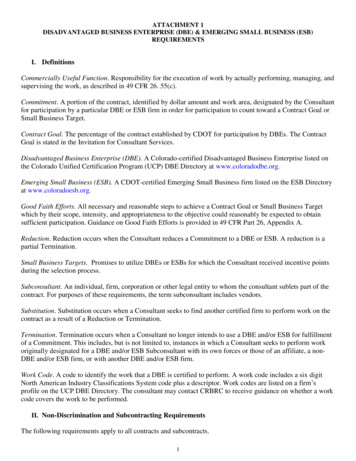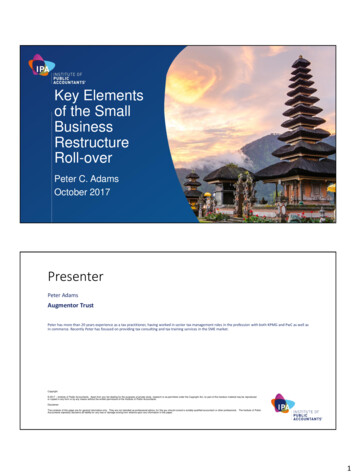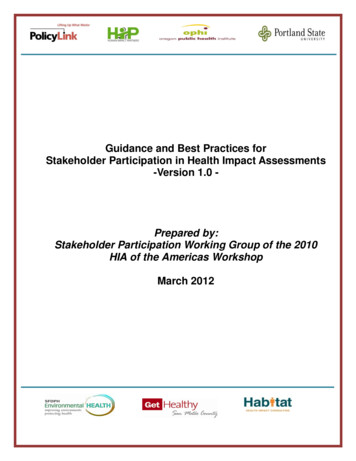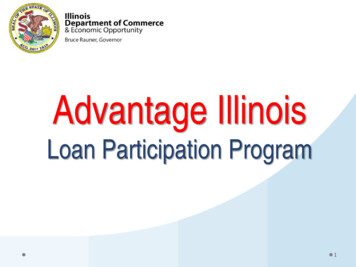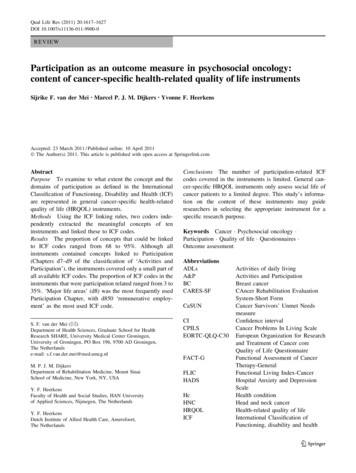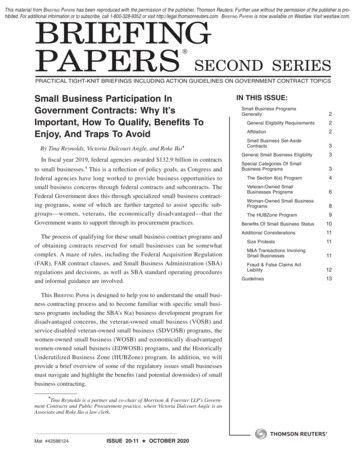
Transcription
This material from Briefing Papers has been reproduced with the permission of the publisher, Thomson Reuters. Further use without the permission of the publisher is prohibited. For additional information or to subscribe, call 1-800-328-9352 or visit http://legal.thomsonreuters.com. Briefing Papers is now available on Westlaw. Visit westlaw.com.BRIEFINGPAPERS SECOND SERIES PRACTICAL TIGHT-KNIT BRIEFINGS INCLUDING ACTION GUIDELINES ON GOVERNMENT CONTRACT TOPICSSmall Business Participation InGovernment Contracts: Why It’sImportant, How To Qualify, Benefits ToEnjoy, And Traps To AvoidBy Tina Reynolds, Victoria Dalcourt Angle, and Roke Iko*In fiscal year 2019, federal agencies awarded 132.9 billion in contractsto small businesses.1 This is a reflection of policy goals, as Congress andfederal agencies have long worked to provide business opportunities tosmall business concerns through federal contracts and subcontracts. TheFederal Government does this through specialized small business contracting programs, some of which are further targeted to assist specific subgroups—women, veterans, the economically disadvantaged—that theGovernment wants to support through its procurement practices.The process of qualifying for these small business contract programs andof obtaining contracts reserved for small businesses can be somewhatcomplex. A maze of rules, including the Federal Acquisition Regulation(FAR), FAR contract clauses, and Small Business Administration (SBA)regulations and decisions, as well as SBA standard operating proceduresand informal guidance are involved.This BRIEFING PAPER is designed to help you to understand the small business contracting process and to become familiar with specific small business programs including the SBA’s 8(a) business development program fordisadvantaged concerns, the veteran-owned small business (VOSB) andservice-disabled veteran-owned small business (SDVOSB) programs, thewomen-owned small business (WOSB) and economically disadvantagedwomen-owned small business (EDWOSB) programs, and the HistoricallyUnderutilized Business Zone (HUBZone) program. In addition, we willprovide a brief overview of some of the regulatory issues small businessesmust navigate and highlight the benefits (and potential downsides) of smallbusiness contracting.*Tina Reynolds is a partner and co-chair of Morrison & Foerster LLP’s Government Contracts and Public Procurement practice, where Victoria Dalcourt Angle is anAssociate and Roke Iko a law clerk.Mat #42588124ISSUE 20-11 OCTOBER 2020IN THIS ISSUE:Small Business ProgramsGenerally2General Eligibility Requirements2Affiliation2Small Business Set-AsideContracts3General Small Business Eligibility3Special Categories Of SmallBusiness Programs3The Section 8(a) Program4Veteran-Owned SmallBusinesses Programs6Woman-Owned Small BusinessPrograms8The HUBZone Program9Benefits Of Small Business Status10Additional Considerations11Size Protests11M&A Transactions InvolvingSmall Businesses11Fraud & False Claims ActLiability12Guidelines13
OCTOBER 2020 20-11Small Business Programs GenerallyIn establishing the Small Business Act,2 Congressrecognized the importance of small businesses in ourcompetitive economy and announced its intent to “aid,counsel, assist, and protect, insofar as is possible, theinterest of small-business concerns.”3 The legislation wasdesigned to ensure that some portion of the total Government purchases of goods and services be placed withsmall-business enterprises, which Congress thought necessary “to maintain and strengthen the overall economyof the Nation.”4General Eligibility RequirementsPer SBA regulations, a small business must be organized for profit, with a place of business located in theUnited States, and must either operate primarily withinthe United States or otherwise “make[] a significant contribution to the U.S. economy through payment of taxesor use of American products, materials or labor.”5 In addition, the company must be considered “small.”Whether or not a company is considered small is basedon specific size standards, which can be found in SBAregulations at 13 C.F.R. Part 121. Size status is measuredbased on the economic sector into which your businessfalls. Businesses are categorized using the North American Industry Classification System (NAICS) code orcodes that best match the nature of the company’sbusiness.6 The SBA has established a size standard foreach NAICS code that is based either on average annualreceipts7 or on the average number of employees.8 Thesesize definitions and ceilings vary from industry to industry to reflect different conceptions of what is considered“small” in any given business sector. For example, anautomotive repair company (NAICS Code 811111) isBRIEFING PAPERSconsidered small with 8 million in average annualreceipts, while a new home builder (NAICS Code236117) is small with 39.5 million in average annualreceipts.9 Similarly, a wholesaler of fruits and vegetables(NAICS Code 424480) is small if it has under 100 employees on a 12-month average basis, while an aircraftmanufacturer (NAICS Code 336411) is small at under1,500 employees over the same period.10Government purchasers assign a NAICS code to eachparticular procurement, and companies wishing to compete as a small business for that contract must fall withinthe applicable size standard for that designated NAICScode.11 Note that for some specialized programs, such asthe Small Business Innovation Research Program, thesize standards are different.12So how do you go about calculating eligibility basedon revenues or number of employees? For revenue-basedNAICS codes, recent changes to the small business sizestandards have increased the calculation time period foraverage annual receipts from three years to five years.13The final rule implementing this change went into effectJanuary 6, 2020, and provides for a transition periodthrough January 6, 2022.14 For proposals submitted priorto January 6, 2022, then, you may select either a threeyear period or a five-year period to calculate your average annual revenues.15 Employee-based calculations arenot impacted by this rule. Where a size standard is basedon the number of employees, that number is calculatedbased upon an annual average, by considering the average number of employees for each of the pay periods forthe preceding 12 calendar months.16AffiliationWhen calculating size status, companies must countEditor: Valerie L. GrossK2020 Thomson Reuters. All rights reserved.For authorization to photocopy, please contact the Copyright Clearance Center at 222 Rosewood Drive, Danvers, MA 01923, USA (978)750-8400, http://www.copyright.com or West’s Copyright Services at 610 Opperman Drive, Eagan, MN 55123, copyright.west@thomsonreuters.com. Please outline the specific material involved, the number of copies you wish to distribute and the purpose or format of the use.This publication was created to provide you with accurate and authoritative information concerning the subject matter covered; however,this publication was not necessarily prepared by persons licensed to practice law in a particular jurisdiction. The publisher is not engaged inrendering legal or other professional advice and this publication is not a substitute for the advice of an attorney. If you require legal or otherexpert advice, you should seek the services of a competent attorney or other professional.Briefing PapersL (ISSN 0007-0025) is published monthly, except January (two issues) and copyrighted by Thomson Reuters, 610 OppermanDrive, P.O. Box 64526, St. Paul, MN 55164-0526. Customer Service: (800) 328-4880. Periodical Postage paid at St. Paul, MN.POSTMASTER: Send address changes to Briefing Papers, 610 Opperman Drive, P.O. Box 64526, St. Paul, MN 55164-0526.2K 2020 Thomson Reuters
BRIEFING PAPERSnot only their own employees and revenues, but also musttake into account any “affiliates” as that term is definedin the SBA regulations. In other words, the regulationsspecify “the maximum allowed for a concern and its affiliates to be considered small.”17 Small businesses thusmust aggregate the revenues and/or employees (as relevant for their NAICS code) of all affiliates with those ofthe company itself to ensure that they remain below themaximum number of employees or annual receipts toremain eligible for small business contract awards.The rules pertaining to what constitutes an affiliate areset forth in 13 C.F.R. § 121.103. Affiliation can take manyforms, including common ownership, common management, familial or contractual relationships, extensivebusiness dealings, and investment control.18 Because it issometimes difficult to determine whether or not anotherconcern may be considered an affiliate, and because theSBA rules on affiliation have been extensively interpretedby SBA case law, if you are uncertain whether or not affiliation may apply, you should contact legal counsel foradditional guidance. As described below, failure toproperly calculate size status, including failure to take affiliation into account, can have significant adverseconsequences.Small Business Set-Aside ContractsContracting officers are encouraged to offer certaintypes of contracts exclusively for small businesses (i.e.,to “set aside” the contract for only small businesses)and/or to give preference to small businesses in the awardprocess. There are several types of set-asides. Some areopen to all small businesses, while others are only opento the special categories of small businesses discussedbelow. Whether a particular contract is set aside for smallbusinesses largely depends on the anticipated value ofthe procurement and the “rule of two.” The “rule of two”involves consideration of whether the contracting officerhas a reasonable expectation of obtaining offers from twoor more responsible small business concerns “that arecompetitive in terms of fair market prices, quality, anddelivery.”19Small business set-asides do not have to pertain to anentire procurement; they can be partial. A contracting officer must set aside a portion or portions of an acquisition(except for construction) for exclusive small businessK 2020 Thomson ReutersOCTOBER 2020 20-11participation when market research indicates that a totalset-aside is not appropriate but the requirement can bedivided into distinct portions and two or more responsiblesmall business concerns are reasonably expected tosubmit offers on the set-aside portion of the work.20Additionally, the FAR requires contracting officers toset aside contracts for special categories of small businesses under some circumstances. For contracts over 250,000, Government contracting officers are to initiallyconsider using one of the small business socioeconomiccontracting programs (e.g., 8(a), HUBZone, SDVOSB,or WOSB programs) before considering a general smallbusiness set-aside.21General Small Business EligibilityWhile the rules for special categories of small businesses can differ, a company competing as a generalsmall business may self-certify that it is small.22 To do so,a company must represent in good faith that (1) it meetsthe small business size standard corresponding to theNAICS code identified in the solicitation, and (2) the SBAhas not issued a written determination finding the company other than small.23 Representations as to size statusare made at the time of initial offer for most programs.24The contracting officer must accept an offeror’s size representation unless (1) another offeror or interested partychallenges the concern’s small business representation,or (2) the contracting officer has a reason to question therepresentation.25 Any size representation challenge mustbe referred to the SBA, 26 which will then evaluatewhether a company qualifies as a small business.27 (Moreon SBA size protests below.)Special Categories Of Small BusinessProgramsAs mentioned, certain types of small businesses aregiven preferential treatment by the Federal Government,and contracting officers are encouraged to consider anacquisition for one of these small business socioeconomiccontracting programs before considering a general smallbusiness set-aside.28 To qualify for these socioeconomicprograms, a business must first be a small business. TheSBA can then consider the business’ ownership and geography for eligibility in other programs. The most common small business socioeconomic contracting programs3
OCTOBER 2020 20-11BRIEFING PAPERSdiscussed in this PAPER are the SBA’s 8(a) businessdevelopment program for socially and economicallydisadvantaged businesses, the VOSB and SDVOSBprograms, the WOSB and EDWOSB programs, and theHUBZone program.that are owned and controlled by socially and economically disadvantaged individuals “so that such concernscan compete on an equal basis in the American economy,”and to provide these companies the tools necessary tosucceed.34Congress has established Government-wide procurement contracting goals based on both small businessesgenerally and these specific sub-categories of small businesses and measures agency performance against thesegoals. The small business contracting goals for eachagency are:In fiscal year 2019, 8(a) participants were awarded 30.4 billion in federal contracts, including 8.6 billionin 8(a) set-aside awards and 9.9 billion in 8(a) solesource awards.35E At least 23% of the total value of all prime contractawards to small businesses;E 5% of the total value of all prime contract awardsand subcontract awards to small socially and economically disadvantaged businesses (8(a) businesses);E 5% of the total value of all prime contract awardsand subcontract awards to service-disabled veteranowned small businesses;E 5% of the total value of all prime contract awardsand subcontract awards to women-owned smallbusinesses; andE 3% of the total value of all prime contract awardsand subcontract awards to HUBZone small businesses for each fiscal year.29The SBA tracks agencies’ performance against thesesmall business participation goals and presents the resultsin the SBA’s annual Small Business ProcurementScorecards. 30 In fiscal year 2019, federal agenciesawarded 132.9 billion in contracts to small business,which represented 26.5% of federal contracting dollars,3.5% higher than the Government’s statutory target.31The Section 8(a) ProgramSection 8(a) of the Small Business Act, 15 U.S.C.A.§ 637, commonly referred to as the “8(a) program,”authorizes the SBA to enter into agreements with otheragencies to encourage award of contracts to firms eligiblefor program participation.32 Contracts may be awarded to8(a) program participants on a sole-source or competitivebasis.33 The 8(a) program is designed to assist companies4To be eligible for the 8(a) program, a company mustmeet the following criteria:E The firm must qualify as a small business concernunder the applicable size standard for its NAICScode;36E The firm must be at least 51% unconditionallyowned and controlled by one or more socially andeconomically disadvantaged individuals who are ofgood character and citizens of and residing in theUnited States (except for concerns owned by Native American tribes, Alaska Native Corporations,Native Hawaiian Organizations, or CommunityDevelopment Corporations);37 andE The firm must demonstrate a potential for success.38Ownership is considered “unconditional” when it isnot subject to any conditions precedent or subsequent,executory agreements, voting trusts, restrictions on or assignments of voting rights, or other arrangements thatcould cause the benefits of ownership to go to anotherentity.39 Ownership is direct when the disadvantaged individual or individuals own the business in their ownright and not through an intermediary, such as anotherbusiness or by a trust (including employee stock ownership trusts).40In addition to these requirements, a disadvantaged individual must hold the highest officer position (usuallypresident or chief executive officer) within the business.41The 8(a) company’s business and daily business operations must be conducted on a full-time basis by one ormore disadvantaged individuals who have “managerialexperience of the extent and complexity needed to runthe concern.”42To maintain 8(a) status, the same disadvantaged ap-K 2020 Thomson Reuters
BRIEFING PAPERSplicant or applicants that were part of the initial 8(a) application must maintain 51% or more of the ownershipand control.43 Ownership cannot simply be transferred toanother disadvantaged individual.44 However, “[a]ny Participant that was awarded one or more 8(a) contracts maysubstitute one disadvantaged individual for anotherdisadvantaged individual without requiring the termination of those contracts or a request for waiver under [13C.F.R.] § 124.515, as long as it receives SBA’s approvalprior to the change.”45Who exactly is considered “disadvantaged” for purposes of the 8(a) program? Generally, “[s]ocially disadvantaged individuals are those who have been subjectedto racial or ethnic prejudice or cultural bias within American society because of their identities as members ofgroups and without regard to their individual qualities.”46Members of designated racial and ethnic groups arepresumed to be socially disadvantaged.47 Individuals whoare not members of one of these designated groups mayqualify for participation, but they “must establish individual social disadvantage by a preponderance of theevidence.”48“Economically disadvantaged individuals” are thosethat have historically had limited access to capital andcredit.49 Generally, to qualify as “economically disadvantaged,” the net worth of an individual must be less than 750,000.50 The SBA will presume that an individual isnot economically disadvantaged if his or her adjustedgross income averaged over the past three years exceeds 350,000.51 Furthermore, an individual will generally notbe considered economically disadvantaged if the fairmarket value of all of his or her assets (including his orher primary residence and the value of the 8(a) applicant/participant firm) exceeds 6 million.52 If the applicant ismarried, his or her spouse’s assets are also considered.53In determining whether an applicant has “good character,” the SBA considers (and may use as a basis fordisqualification) any possible criminal conduct by the applicant, violations of SBA regulations, debarment orsuspension from Government contracting, evidence of alack of business integrity on the part of a manager or keyemployee, current incarceration, parole, or probation fora felony or any crime involving business integrity, andthe knowing submission of false information to theSBA.54K 2020 Thomson ReutersOCTOBER 2020 20-11For a firm to demonstrate “potential for success,” itgenerally must be in business for at least two full yearsimmediately prior to the date of its 8(a) application.55The SBA may waive the two-year requirement if the following conditions are met: (1) the disadvantaged individual upon whom eligibility is based has substantial business management experience; (2) the applicant hasdemonstrated technical experience and a sound businessplan; (3) the applicant has adequate capital to sustain itsoperations and carry out its business plan; (4) the applicant has a record of successful performance on priorcontracts within its business category; and (5) the applicant has or can show that it will have, the personnel,facilities, equipment, and any other resources needed toperform 8(a) contracts.56 A successful applicant mustdemonstrate both technical knowledge in its primaryindustry category and management experience sufficientto run its day-to-day operations.57 Furthermore, the applicant, or its employees, must hold all necessary professional licensing for its primary industry.58The 8(a) applicant cannot self-certify as a participantin the program. Instead, they must submit an applicationand be approved by the SBA to be admitted to theprogram. Applicants can request admission to the 8(a)program via an electronic application available on theSBA’s website.59 A complete application must includesignificant amounts of documentation, including financialstatements, copies of filed federal personal and businesstax returns, individual and business bank statements,personal history statements, and any additional documents the SBA deems necessary to determine eligibility.60Generally, the SBA will advise applicants within 15 daysafter the receipt of an application whether the applicationis complete and suitable for evaluation and, if not, whatadditional information or clarification is required tocomplete the application.61 The SBA will process an 8(a)program application within 90 days of receipt of acomplete application package.62To retain eligibility to participate in the 8(a) small business program after certification, a firm must generallyremain small for its primary industry classification andmust continue to meet all eligibility criteria contained in13 C.F.R. § 124.101 through § 124.108.63 Companiesmay remain part of the 8(a) program for nine years.64 After that they “graduate” from their 8(a) status, althoughthey may still be considered small businesses if they5
OCTOBER 2020 20-11otherwise remain eligible. The SBA may graduate an 8(a)participant early if the firm exceeds the size standard corresponding to its primary NAICS code for three consecutive years.65Participation in the 8(a) program includes as a majoradvantage the ability of companies to compete for contracts set aside specifically for 8(a) contractors.66 Thesecontracts may be competed where at least two 8(a)participants are expected to submit proposals or may beawarded on a sole-source basis.67Veteran-Owned Small Businesses ProgramsCongress has authorized unique benefits to small businesses owned by military veterans, including the opportunity to compete for certain set-aside procurements.Both SDVOSBs and, to a more limited extent, VOSBsare eligible for preferences in Government procurementsthrough two programs designed by Congress—theSDVOSB Procurement Program (the SBA refers to theprogram as the Service-Disabled Veteran-Owned(SDVO) Small Business Concern (SBC) program68) andthe Veterans First Contracting Program.Because “the United States ha[d] done too little to assist veterans, particularly service-disabled veterans, inplaying a greater role in the economy,”69 Congress firstaimed to assist veterans in 1999 by expanding the eligibility for certain small business assistance programs toinclude veterans, directing certain federal agencies toenhance small business assistance to VOSBs andSDVOSBs, and establishing new institutions to providesmall business assistance to veterans or to support theinstitutions that provide such assistance.70 Subsequently,Congress enacted the Veterans Benefits Act of 2003,which amended the Small Business Act to allow contracting officers to award sole-source and set-aside contractsto SDVOSBs.71Under these authorities, a Government agency can restrict competition to only SDVOSBs if it determines thatat least two SDVOSBs will submit offers at a fair marketprice.72 An agency can award a sole-source contract to anSDVOSB if it expects only one qualified SDVOSB tosubmit an offer, the anticipated award price of the contractwill not exceed the sole-source limit (currently, 4 million or 6.5 million for manufacturing contracts73), andthe contract award can be made at a fair and reasonableprice.746BRIEFING PAPERSIn 2004, President George W. Bush also issued Executive Order 13360 to increase federal contracting andsubcontracting opportunities for SDVOSBs.75 The Orderrequired each federal agency to develop a strategy toincrease contracting and subcontracting with SDVOSBs,designate a senior-level official to be responsible fordeveloping and implementing the agency’s strategy, andreport its progress annually to the SBA.76 Specifically,the Order directed the Administrator of General Servicesto “establish a Government-Wide Acquisition Contractreserved for participation by service-disabled veteranbusinesses” and “assist service-disabled veteran businesses to be included in Federal Supply Schedules.”77 Inresponse, the General Services Administration (GSA)created the Veterans Technology Services (VETS) Governmentwide Acquisition Contract (GWAC), an IT services set-aside contract reserved exclusively forSDVOSBs.78 A successor contract, Veterans TechnologyServices 2 or “VETS 2,” enables the GSA to continue itssupport of the SDVOSB Procurement Program, whilehelping federal agencies achieve their socioeconomicobjectives.79Today, the SBA administers the SDVOSB program andassists federal agencies in meeting agency goals for theprogram, finding SDVOSB firms through the small business database, overseeing SDVOSB contract challenges,and determining which contract vehicles are most appropriate for the agency’s needs.80 Consistent with theapplicable statutes and the SBA’s regulations under theSDVOSB program, contracting officers may awardcontracts using either sole-source or set-aside procedures,although they must consider set-aside contract vehiclesfirst.81In addition to this SBA-run program for all federalagencies, the Department of Veterans Affairs (VA) has itsown veterans’ business program through which it buysgoods and services from veteran-owned companies.Under the authority of the Veterans Benefits, Health Care,and Information Technology Act of 2006, the VA createdthe Veterans First Contracting Program to increaseveteran participation in Government procurement.82 Theprogram allows the VA to grant SDVOSBs and VOSBspreference in VA procurements for set-aside and solesource contracts.83 Under the Veterans First ContractingProgram, the VA is required to determine whether thereare at least two VOSBs or SDVOSBs that could submitK 2020 Thomson Reuters
BRIEFING PAPERSoffers for an acquisition at a fair and reasonable price.84If so, the VA must set-aside the procurement forSDVOSBs or VOSBs,85 with priority given toSDVOSBs.86 In 2016, the U.S. Supreme Court confirmedthe priority of this “rule of two” approach and the prioritization of VOSBs and SDVOSBs over all other types ofset asides in Kingdomware Technologies, Inc. v. UnitedStates.87Notably, the Veterans First program sets higher procurement goals than the SDVOSB program. The VA’sfiscal year 2019 prime contracting goals for the VeteransFirst program were 17.0% for VOSBs and 15.0% forSDVOSBs, compared to the fiscal year 2019 goal for theSDVOSB Procurement Program of 3%.88With that overview of the veterans’ small businessprograms, let’s take a look at eligibility requirements forSDVOSBs and VOSBs. Historically, the SBA and VAeach applied their own eligibility requirements for theirrespective programs (the SBA’s SDVOSB ProcurementProgram or the VA’s Veterans First Contracting Program).However, in 2016 Congress directed the SBA and VA toconsolidate their certification programs to ensure uniformity in SDVOSB regulations.89 In 2018, the SBA and theVA issued new regulations for the SDVOSB and VOSBcertification processes. 90 The VA continues to makedeterminations about applicant firms to certify SDVOSBsand VOSBs for VA contracts, but now applies the SBA’sdefinitions of control and ownership in connection withits certification analysis.91To compete for Government contracts as a SDVOSBor VOSB, firms generally must:E Be a small business;E Be at least 51% owned and controlled by one ormore veterans; andE Have one or more veterans manage day-to-dayoperations and also make long-term decisions.92OCTOBER 2020 20-11tive military, naval, or air service and who was dischargedor released under conditions other than a dishonorabledischarge.95 A service-disabled veteran must have suffered a disability that is “service-connected,” such thatthe disability was incurred or aggravated in the line ofduty in the active military, naval, or air service.96As noted, under SBA regulations, a VOSB or SDVOSBmust be “at least 51% unconditionally and directly ownedby one or more [veterans or service-disabled veterans].”97“Unconditionally” in this context means that the veteran’sownership cannot be subject to any restrictions and directly means that the veteran must own the company outright as socioeconomic status does not “trickle down”through corporate structures such as parent, affiliate, orsubsidiary forms. For publicly owned businesses, no lessthan 51% of the stock must be owned by one or more veterans.98 For partnerships, at least 51% of aggregate votinginterest must be unconditionally owned by one or moreveterans or service-disabled veterans, and in general oneor more veterans must receive at least 51% of the annualdistribution of profits paid to owners of the corporation,partnership, etc.99To qualify as veteran-controlled, both long-term andday-to-day management and administration of businessoperations must be conducted by one or more veterans(or service-disabled veterans depending on theprogram).100 A veteran (or service-disabled veteran) alsomust hold the highest officer position (e.g., president,chief executive officer) in the company and must havethe managerial experience necessary to run the company.The veteran (or service-disabled veteran) does not needto have technical experience or required licenses but doesneed “ultimate managerial and supervisory control” overemployees who possess the technical expertise or required license.101Other circumstances and factors that indicate whethera veteran does or does not control a business includewhether the veteran:E Controls the board of directors;SDVOSBs must be owned by a veteran with a serviceconnected disability (as that term is defined by the VA93),who also has day-to-day control over operations andlong-term decisionmaking.94The terms “veteran” and “service-disabled veteran”are defined by statute as a person who served in the ac-K 2020 Thomson ReutersE Has the capacity to overcome a super majority;E Works normal business hours;E Lives in close proximity to firm headquarters; andE Receiv
acquisition for one of these small business socioeconomic contracting programs before considering a general small business set-aside.28 To qualify for these socioeconomic programs, a business must first be a small business. The SBA can then consider the business' ownership and ge-ography for eligibility in other programs. The most com-
